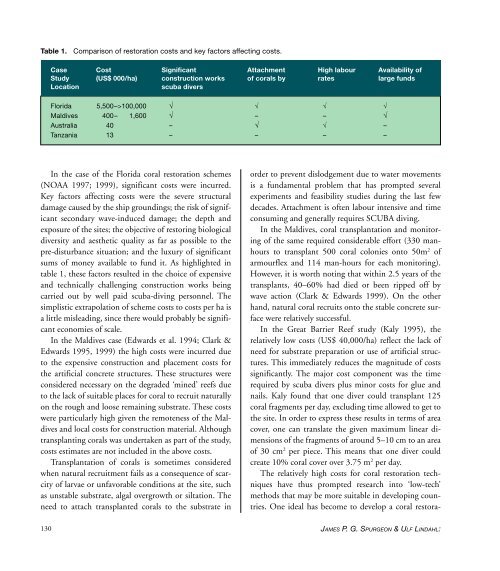Create successful ePaper yourself
Turn your PDF publications into a flip-book with our unique Google optimized e-Paper software.
Table 1.<br />
Comparison <strong>of</strong> restoration costs and key factors affecting costs.<br />
Case Cost Significant Attachment High labour Availability <strong>of</strong><br />
Study (US$ 000/ha) construction works <strong>of</strong> corals by rates large funds<br />
Location<br />
scuba divers<br />
Florida 5,500–>100,000 √ √ √ √<br />
Maldives 400– 1,600 √ – – √<br />
Australia 40 – √ √ –<br />
Tanzania 13 – – – –<br />
In the case <strong>of</strong> the Florida coral restoration schemes<br />
(NOAA 1997; 1999), significant costs were incurred.<br />
Key factors affecting costs were the severe structural<br />
damage caused by the ship groundings; the risk <strong>of</strong> significant<br />
secondary wave-induced damage; the depth and<br />
exposure <strong>of</strong> the sites; the objective <strong>of</strong> restoring biological<br />
diversity and aesthetic quality as far as possible to the<br />
pre-disturbance situation; and the luxury <strong>of</strong> significant<br />
sums <strong>of</strong> money available to fund it. As highlighted in<br />
table 1, these factors resulted in the choice <strong>of</strong> expensive<br />
and technically challenging construction works being<br />
carried out by well paid scuba-diving personnel. The<br />
simplistic extrapolation <strong>of</strong> scheme costs to costs per ha is<br />
a little misleading, since there would probably be significant<br />
economies <strong>of</strong> scale.<br />
In the Maldives case (Edwards et al. 1994; Clark &<br />
Edwards 1995, 1999) the high costs were incurred due<br />
to the expensive construction and placement costs for<br />
the artificial concrete structures. These structures were<br />
considered necessary on the degraded ‘mined’ reefs due<br />
to the lack <strong>of</strong> suitable places for coral to recruit naturally<br />
on the rough and loose remaining substrate. These costs<br />
were particularly high given the remoteness <strong>of</strong> the Maldives<br />
and local costs for construction material. Although<br />
transplanting corals was undertaken as part <strong>of</strong> the study,<br />
costs estimates are not included in the above costs.<br />
Transplantation <strong>of</strong> corals is sometimes considered<br />
when natural recruitment fails as a consequence <strong>of</strong> scarcity<br />
<strong>of</strong> larvae or unfavorable conditions at the site, such<br />
as unstable substrate, algal overgrowth or siltation. The<br />
need to attach transplanted corals to the substrate in<br />
order to prevent dislodgement due to water movements<br />
is a fundamental problem that has prompted several<br />
experiments and feasibility studies during the last few<br />
decades. Attachment is <strong>of</strong>ten labour intensive and time<br />
consuming and generally requires SCUBA diving.<br />
In the Maldives, coral transplantation and monitoring<br />
<strong>of</strong> the same required considerable effort (330 manhours<br />
to transplant 500 coral colonies onto 50m 2 <strong>of</strong><br />
armourflex and 114 man-hours for each monitoring).<br />
However, it is worth noting that within 2.5 years <strong>of</strong> the<br />
transplants, 40–60% had died or been ripped <strong>of</strong>f by<br />
wave action (Clark & Edwards 1999). On the other<br />
hand, natural coral recruits onto the stable concrete surface<br />
were relatively successful.<br />
In the Great Barrier Reef study (Kaly 1995), the<br />
relatively low costs (US$ 40,000/ha) reflect the lack <strong>of</strong><br />
need for substrate preparation or use <strong>of</strong> artificial structures.<br />
This immediately reduces the magnitude <strong>of</strong> costs<br />
significantly. The major cost component was the time<br />
required by scuba divers plus minor costs for glue and<br />
nails. Kaly found that one diver could transplant 125<br />
coral fragments per day, excluding time allowed to get to<br />
the site. In order to express these results in terms <strong>of</strong> area<br />
cover, one can translate the given maximum linear dimensions<br />
<strong>of</strong> the fragments <strong>of</strong> around 5–10 cm to an area<br />
<strong>of</strong> 30 cm 2 per piece. This means that one diver could<br />
create 10% coral cover over 3.75 m 2 per day.<br />
The relatively high costs for coral restoration techniques<br />
have thus prompted research into ‘low-tech’<br />
methods that may be more suitable in developing countries.<br />
One ideal has become to develop a coral restora-<br />
130<br />
JAMES P. G. SPURGEON & ULF LINDAHL:


















